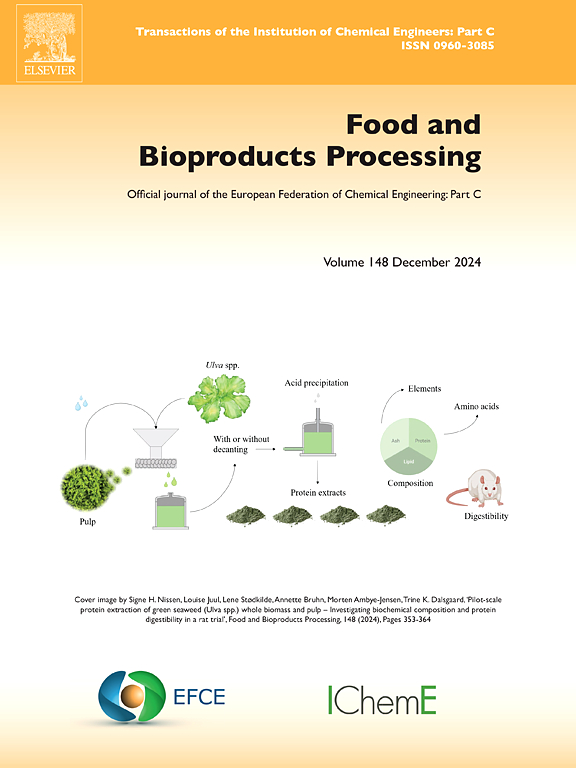从苹果渣中提取具有抗氧化、抗菌和益生元活性的生物活性成分
IF 3.5
2区 农林科学
Q2 BIOTECHNOLOGY & APPLIED MICROBIOLOGY
引用次数: 0
摘要
苹果渣(Apple pomace, AP)是苹果产业未被充分利用的副产品,在循环生物经济系统中具有很高的加工潜力,可以获得满足社会需求的生物基产品。本研究强调了通过微波提取生物活性化合物并随后将苹果渣提取物(APE)掺入MCM-41介孔二氧化硅基质中以防止APE降解,从而使AP具有优越的价值,目的是作为一种生物活性成分用于开发新的功能食品。通过UV-Vis、UHPLC-MS/MS和UHPLC-DAD对APE进行了生物活性表征,并通过FTIR、UV-Vis、SEM和TGA-DSC对APE在mcm -41型二氧化硅基体上的负载进行了验证。通过抗菌活性、益生元效应和体外生物相容性等指标测定所得成分的生物活性。得到的黄酮类化合物含有较高的总多酚(136.00 mg GAE/g)和总黄酮(34.00 mg QE/g)含量,具有良好的抗氧化活性(1800.00µmol Trolox/g)。UHPLC-MS/MS表征表明,APE中含有大量的抗氧化活性化合物,如t-肉桂酸(23.51 mg/g)、槲皮素(22.86 mg/g)和杨梅素(97.24 mg/g),以及其他特定的生物活性化合物,如黄酮类化合物、黄酮类化合物的糖基化形式、查尔酮和二苯乙烯。将苹果多酚提取物成功加载到MCM-41中,得到的生物活性成分对病原菌具有抗菌作用,特别是对与痢疾有关的S. flexneri菌株(0.625 mg/mL),但也有益生元作用,特别是对L929小鼠成纤维细胞细胞系的L. paracasei菌株(低于1.2 mg/mL)无细胞毒性。这些结果进一步支持了MCM-41硅基负载多酚提取物在开发新的食品制剂和功能保健品方面的潜在应用。本文章由计算机程序翻译,如有差异,请以英文原文为准。
Valorization of apple pomace by obtaining some bioactive ingredients with antioxidant, antimicrobial and prebiotic activities
Apple pomace (AP) is an underutilized by-product from the apple industry that has a high processing potential to obtain biobased products that meet the needs of the society, in the circular bioeconomy system. This study highlights the superior valorization of AP through microwave extraction of bioactive compounds and subsequent incorporation of apple pomace extract (APE) into the MCM-41 mesoporous silica matrix to prevent APE degradation, with the aim of being used as a bioactive ingredient for the development of new functional food products.The bioactive characterization of the APE was performed by UV-Vis, UHPLC-MS/MS and UHPLC-DAD investigations, while the loading of the APE into MCM-41-type silica matrix was confirmed by FTIR, UV-Vis, SEM and TGA-DSC investigations. The biological activity of the obtained ingredient was determined by evaluating the antimicrobial activity, prebiotic effect and in vitro biocompatibility. The obtained APE contained high total polyphenolic (136.00 mg GAE/g) and flavonoids (34.00 mg QE/g) contents and had a good antioxidant activity (1800.00 µmol Trolox/g). UHPLC-MS/MS characterization of the APE indicated important amounts of antioxidant bioactive compounds such as t-cinnamic acid (23.51 mg/g) quercetin (22.86 mg/g) and myricetin (97.24 mg/g), but also the presence of other specific bioactive compounds such as flavonoids and the glycosylated forms of flavonoids, chalchones and stilbenes. The apple polyphenolic extract was successfully loaded into MCM-41 and the resulted bioactive ingredient demonstrate antimicrobial activity against pathogenic strains, especially on the S. flexneri strain (0.625 mg/mL), a microorganism involved in dysentery, but also prebiotic effect, especially on the L. paracasei strain at noncytotoxic concentrations on L929 murine fibroblasts cell line (lower than 1.2 mg/mL). These results support further potential utilization of MCM-41 silica matrix loaded with polyphenolic extract for developing new food preparation and functional health products.
求助全文
通过发布文献求助,成功后即可免费获取论文全文。
去求助
来源期刊

Food and Bioproducts Processing
工程技术-工程:化工
CiteScore
9.70
自引率
4.30%
发文量
115
审稿时长
24 days
期刊介绍:
Official Journal of the European Federation of Chemical Engineering:
Part C
FBP aims to be the principal international journal for publication of high quality, original papers in the branches of engineering and science dedicated to the safe processing of biological products. It is the only journal to exploit the synergy between biotechnology, bioprocessing and food engineering.
Papers showing how research results can be used in engineering design, and accounts of experimental or theoretical research work bringing new perspectives to established principles, highlighting unsolved problems or indicating directions for future research, are particularly welcome. Contributions that deal with new developments in equipment or processes and that can be given quantitative expression are encouraged. The journal is especially interested in papers that extend the boundaries of food and bioproducts processing.
The journal has a strong emphasis on the interface between engineering and food or bioproducts. Papers that are not likely to be published are those:
• Primarily concerned with food formulation
• That use experimental design techniques to obtain response surfaces but gain little insight from them
• That are empirical and ignore established mechanistic models, e.g., empirical drying curves
• That are primarily concerned about sensory evaluation and colour
• Concern the extraction, encapsulation and/or antioxidant activity of a specific biological material without providing insight that could be applied to a similar but different material,
• Containing only chemical analyses of biological materials.
 求助内容:
求助内容: 应助结果提醒方式:
应助结果提醒方式:


